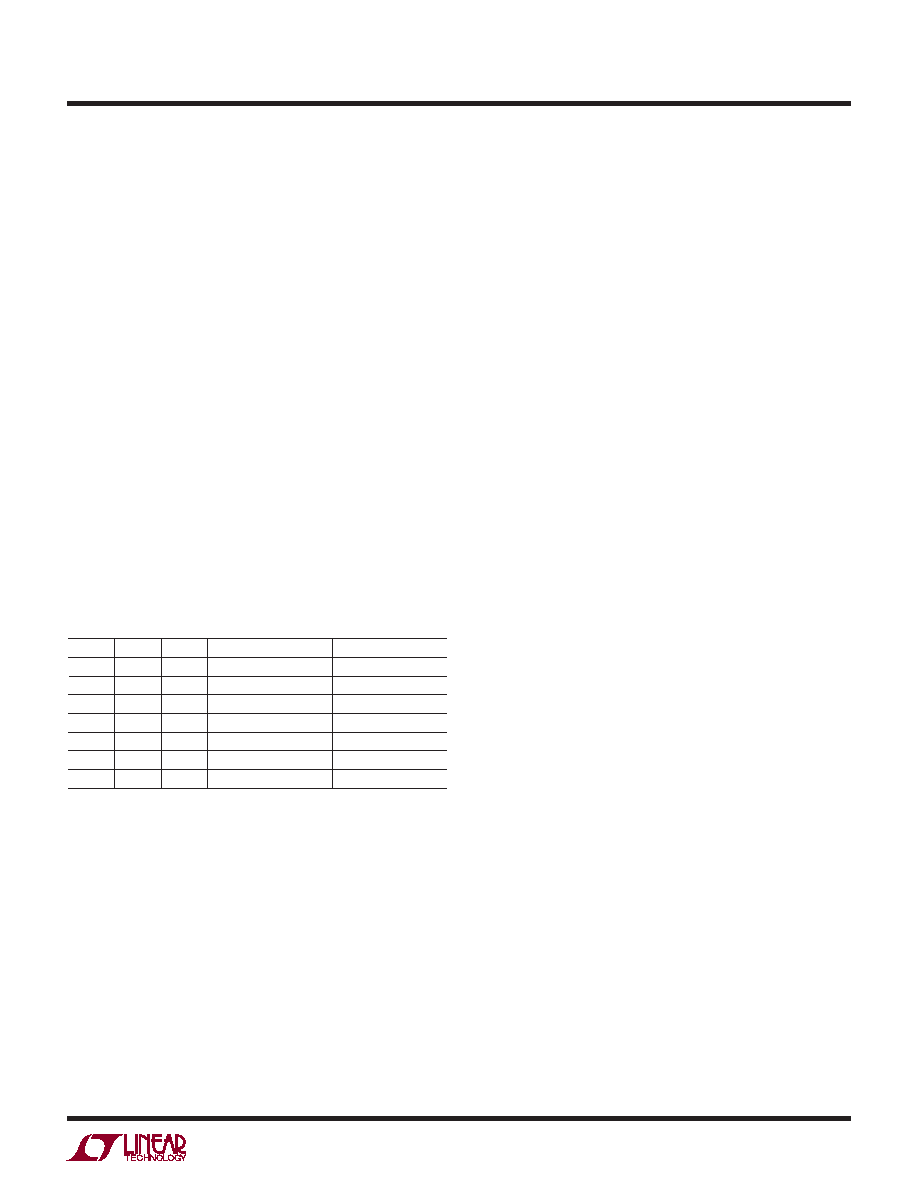- 您現(xiàn)在的位置:買賣IC網(wǎng) > PDF目錄44987 > LT6107MPS5#TRM (LINEAR TECHNOLOGY CORP) SPECIALTY ANALOG CIRCUIT, PDSO5 PDF資料下載
參數(shù)資料
| 型號(hào): | LT6107MPS5#TRM |
| 廠商: | LINEAR TECHNOLOGY CORP |
| 元件分類: | 模擬信號(hào)調(diào)理 |
| 英文描述: | SPECIALTY ANALOG CIRCUIT, PDSO5 |
| 封裝: | PLASTIC, MO-193, TSOT-23, 5 PIN |
| 文件頁數(shù): | 10/12頁 |
| 文件大小: | 279K |
| 代理商: | LT6107MPS5#TRM |

LT6107
7
6107fb
APPLICATIONS INFORMATION
Introduction
The LT6107 high side current sense amplier (Figure 1) pro-
videsaccuratemonitoringofcurrentthroughauser-selected
sense resistor. The sense voltage is amplied by a user-
selected gain and level shifted from the positive power sup-
ply to a ground-referred output. The output signal is analog
and may be used as is, or processed with an output lter.
Theory of Operation
An internal sense amplier loop forces –IN to have the
same potential as +IN. Connecting an external resistor,
RIN, between –IN and V+ forces a potential across RIN
that is the same as the sense voltage across RSENSE. A
corresponding current, VSENSE/RIN, will ow through RIN.
The high impedance inputs of the sense amplier will not
conduct this current, so it will ow through an internal
PNP to the output pin as IOUT.
The output current can be transformed into a voltage by
adding a resistor from OUT to V–. The output voltage is
then VO = V– + IOUT ROUT.
Table 1. Useful Gain Congurations
GAIN
RIN
ROUT
VSENSE at VOUT = 5V
IOUT at VOUT = 5V
20
499Ω
10k
250mV
500μA
50
200Ω
10k
100mV
500μA
100
100Ω
10k
50mV
500μA
GAIN
RIN
ROUT
VSENSE at VOUT =
IOUT at VOUT = 2.5V
20
249Ω
5k
125mV
500μA
50
100Ω
5k
50mV
500μA
100
50Ω
5k
25mV
500μA
Selection of External Current Sense Resistor
The external sense resistor, RSENSE, has a signicant ef-
fect on the function of a current sensing system and must
be chosen with care.
First, the power dissipation in the resistor should be con-
sidered. The system load current will cause both heat and
voltage loss in RSENSE. As a result, the sense resistor
should be as small as possible while still providing the
input dynamic range required by the measurement. Note
that input dynamic range is the difference between the
maximum input signal and the minimum accurately mea-
sured signal, and is limited primarily by input DC offset of
the internal amplier of the LT6107. In addition, RSENSE
must be small enough that VSENSE does not exceed the
maximum input voltage specied by the LT6107, even un-
der peak load conditions. As an example, an application
may require that the maximum sense voltage be 100mV.
If this application is expected to draw 2A at peak load,
RSENSE should be no more than 50mΩ.
Once the maximum RSENSE value is determined, the mini-
mum sense resistor value will be set by the resolution or
dynamic range required. The minimum signal that can be
accurately represented by this sense amplier is limited by
the input offset. As an example, the LT6107 has a typical
input offset of 150μV. If the minimum current is 20mA, a
sense resistor of 7.5mΩ will set VSENSE to 150μV. This is
the same value as the input offset. A larger sense resis-
tor will reduce the error due to offset by increasing the
sense voltage for a given load current. Choosing a 50mΩ
RSENSE will maximize the dynamic range and provide a
system that has 100mV across the sense resistor at peak
load (2A), while input offset causes an error equivalent
to only 3mA of load current. Peak dissipation is 200mW.
If a 5mΩ sense resistor is employed, then the effective
current error is 30mA, while the peak sense voltage is
reduced to 10mV at 2A, dissipating only 20mW.
The low offset and corresponding large dynamic range of
the LT6107 make it more exible than other solutions in
this respect. The 150μV typical offset gives 60dB of dy-
namic range for a sense voltage that is limited to 150mV
maximum, and over 70dB of dynamic range if the rated
input maximum of 0.5V is allowed.
Sense Resistor Connection
Kelvin connection of the –IN and +IN inputs to the sense
resistor should be used in all but the lowest power appli-
cations. Solder connections and PC board interconnec-
tions that carry high current can cause signicant error
in measurement due to their relatively large resistances.
One 10mm × 10mm square trace of one-ounce copper is
approximately 0.5mΩ. A 1mV error can be caused by as
little as 2A owing through this small interconnect. This
will cause a 1% error in a 100mV signal. A 10A load cur-
rent in the same interconnect will cause a 5% error for
the same 100mV signal. By isolating the sense traces
from the high current paths, this error can be reduced
相關(guān)PDF資料 |
PDF描述 |
|---|---|
| LT6109IMS-1#PBF | SPECIALTY ANALOG CIRCUIT, PDSO10 |
| LT6109HMS-1#TRPBF | SPECIALTY ANALOG CIRCUIT, PDSO10 |
| LT6555IGN#PBF | TRIPLE 1-CHANNEL, VIDEO MULTIPLEXER, PDSO24 |
| LT6604CUFF-2.5#PBF | SPECIALTY ANALOG CIRCUIT, PQCC34 |
| LT6604CUFF-2.5#TRPBF | SPECIALTY ANALOG CIRCUIT, PQCC34 |
相關(guān)代理商/技術(shù)參數(shù) |
參數(shù)描述 |
|---|---|
| LT6107MPS5-TRMPBF | 制造商:LINER 制造商全稱:Linear Technology 功能描述:High Temperature High Side Current Sense Amp in SOT-23 |
| LT6107MPS5-TRPBF | 制造商:LINER 制造商全稱:Linear Technology 功能描述:High Temperature High Side Current Sense Amp in SOT-23 |
| LT6108AHMS-1#PBF | 制造商:Linear Technology 功能描述:SC-Amps/Current Sense, High Side Current Sense Amplifier with Reference and Comp |
| LT6108AHMS-1#TRPBF | 制造商:Linear Technology 功能描述:SC-Amps/Current Sense, High Side Current Sense Amplifier with Reference and Comp |
| LT6108AHMS-2#PBF | 制造商:Linear Technology 功能描述:SC-Amps/Current Sense, High Side Current Sense Amplifier with Reference and Comp |
發(fā)布緊急采購,3分鐘左右您將得到回復(fù)。